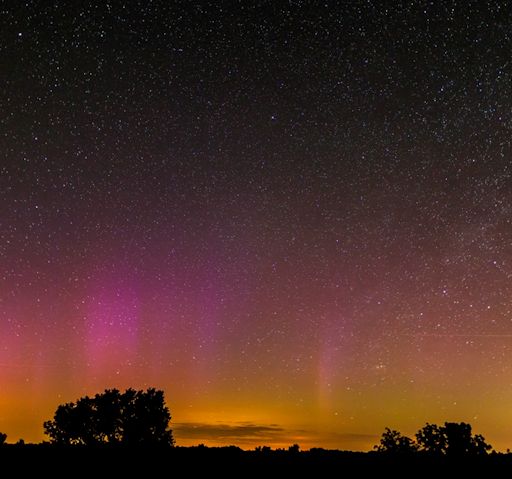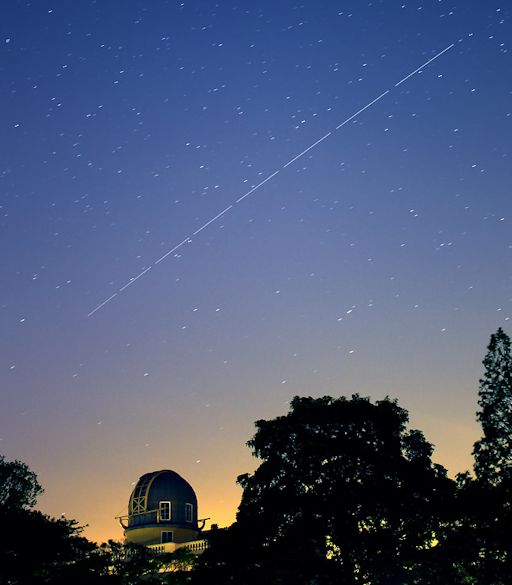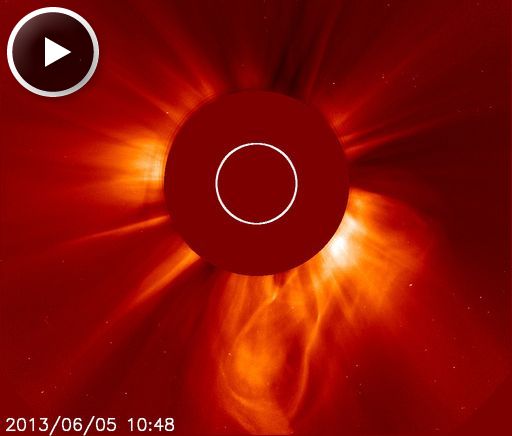When is the best time to see auroras? Where is the best place to go? And how do you photograph them? These questions and more are answered in a new book, Northern Lights - a Guide, by Pal Brekke & Fredrik Broms. | | |
DAYLIGHT METEOR SHOWER: This week, Earth is passing through a stream of debris from asteroid Icarus, source of the annual Arietid meteor shower. The strange thing about this shower is that it occurs mainly during daylight hours. At its peak on June 7-8, as many as 60 Arietids per hour will streak invisibly across the blue sky after sunrise. The best way to observe the Arietids is via radar. Listen to their echoes on Space Weather Radio.
NORTHERN LIGHTS IN THE USA: Last night, Earth passed through a region of south-pointing magnetism in the solar wind. This triggered a G2-class (Kp=6) geomagnetic storm. At its peak, the storm spawned Northern Lights as far south as the central USA. "Yes, I really am in Kansas," says photographer Clay Bramhallwho sends this picture from the plains city of Goff, KS:

"The aurora surprised me," he says. "I could see the lights streaking up and down."
More auroras are in the offing. A CME that left the sun on June 5th is expected to deliver a glancing blow to Earth's magnetic field during the late hours of June 8th (or early hours of June 9th). NOAA forecasters estimate a 65% chance of geomagnetic storms when the CME arrives. Aurora alerts: text, voice.
Realtime Aurora Photo Gallery
ALBERT EINSTEIN ORBITS EARTH: On the afternoon of June 5th, the European Space Agency launched a robotic spaceship named "Albert Einstein" into Earth orbit. Also known as "ATV-4" (Automated Transfer Vehicle 4), the Albert Einstein is a cargo carrier laden with supplies for the International Space Station. Marco Langbroek saw it flying over Leiden, the Netherlands, just two hours after launch:

"The ATV-4 was very bright (mag +1 to +0.5) and easily visible to the naked eye, even from Leiden center," Langbroek. "Still in a low orbit, it was very fast."
To resupply the space station, the Albert Einstein is carrying the most dry cargo ever launched by a European spacecraft--2,480 kilograms, and the most diverse cargo mix--1400 different items. It will catch up to and dock with the ISS on June 15th. As that date approaches, the ATV-4 and the ISS will become visible in the night sky at the same time. Turn your smartphone into an ISS tracker and enjoy the show. ISS Flyby alerts: text, voice.
SOLAR FLARE AND CME: (Updated: June 6, 2013) Southern sunspot AR1762 erupted on June 5th, producing a long-duration M1-class solar flare that peaked around 0900 UT. The explosion hurled a bright coronal mass ejection (CME) into space, shown here in a coronagraph image from the Solar and Heliospheric Observatory:

Although the blast was not Earth-directed, the CME might still affect our planet. Forecast tracks prepared by analysts at NOAA suggest that the CME could deliver a glancing blow to Earth's magnetic field during the late hours of June 8th or early on June 9th. NOAA: 65% chance of polar geomagnetic storms. Aurora alerts: text, voice.
Realtime Space Weather Photo Gallery
Realtime Noctilucent Cloud Photo Gallery
[previous years: 2003, 2004, 2005, 2006, 2007, 2008, 2009, 2011]
Realtime Comet Photo Gallery

